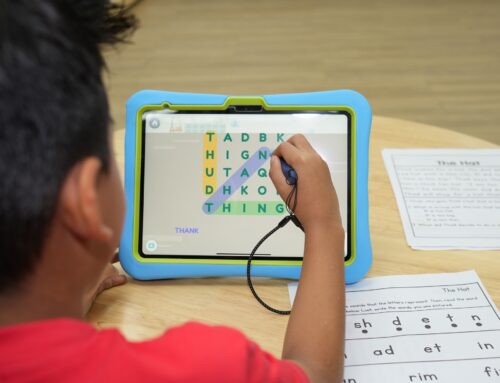Families in Phnom Penh often search for speech therapy that’s practical, consistent, and truly tailored to their child. At OrbRom Center, one reason sessions run smoothly is the quiet, steady work of our Teacher Assistants (TAs) who collaborate with the speech therapist in real time. This post takes today’s session as a starting point and explains how a TA’s presence elevates speech therapy in Phnom Penh—from engagement and behavior support to carry-over at home and school.
Why a TA Changes the Rhythm of Speech Therapy
In a well-run session, timing matters. A TA keeps the routine predictable so the therapist can focus on the communication goal of the moment—sound production, vocabulary building, or social language. This shared focus helps children settle, try, and repeat, which is where real growth happens. For parents in Phnom Penh who want speech therapy that feels calm and productive, the therapist-TA partnership delivers exactly that.
-
The therapist sets the communication target.
-
The TA manages transitions, materials, and attention.
-
The child experiences more successful practice opportunities in less time.
If you’re new to the field, here’s a short primer on the scope of care: What is Speech Therapy?
Engagement First: Getting to Practice Faster
Great sessions reduce the time between instruction and practice. A TA anticipates prompts, hands over visuals or token boards at the right moment, and helps the child return to task after a short movement break. That means more repetitions—key to improving articulation, expanding sentences, and building social communication. To understand how language and interaction fit together, see our overview on Communication and Language.
Consistency Children Can Feel
Progress doesn’t come from a single “perfect” session. It comes from consistent routines that children can count on. TAs help keep the plan steady: same greeting, same warm-up, same reinforcement, and a predictable flow of activities. That consistency lowers anxiety and frees children to communicate more. One-to-one attention is a big part of why this works—learn more here: The Benefits of One-on-One Teaching.
Visual Supports: Clear Cues, Better Communication
Visuals are powerful in speech therapy: first-then boards, choice cards, pacing boards, articulation cue sheets, and simple schedules. The therapist introduces and models; the TA keeps those supports within reach and uses them faithfully. Visuals reduce verbal overload, clarify expectations, and help children plan their turn. Curious why visuals are so effective? Read: Using Visual Supports in Speech Therapy—Why They Work.
Home–School Carry-Over: The TA as a Bridge
Real change shows up outside the therapy room—during snack time, circle time, or playground conversations. Because TAs often see the child in multiple settings, they naturally reinforce therapy targets across the day:
-
Modeling a slower speech rate during class discussion
-
Prompting a functional request (“I want ___”) before a behavior escalates
-
Reusing therapy visuals during transitions
That’s how skills stick—repetition in meaningful moments.
When Assessments Help
If a child’s progress plateaus or the team needs clearer targets, a developmental or speech-language assessment can refine the plan. Assessments identify priorities (sound errors vs. language organization), clarify strengths, and set measurable goals for therapy and classroom support. Get a quick overview of the process here: What Happens During an Autism Assessment?.
-
OrbRom Speech Therapy: We deliver evidence-based care for articulation, language delay, social communication, fluency, and voice. Learn more: OrbRom Speech Therapy in Phnom Penh.
-
OrbRom Assessments: When needed, we provide comprehensive evaluations to inform therapy and school strategies: Assessments at OrbRom Center.
What Parents in Phnom Penh Can Expect at OrbRom
Clear goals. We set practical, family-friendly targets (e.g., “ask for help with a sentence starter,” “produce /s/ in words”).
A calm structure. Sessions begin and end the same way, with a simple visual plan.
A true team. The therapist leads; the TA maintains momentum; families get concise strategies to use at home.
Step-by-step home practice. We give short, doable activities you can fit into routines—teeth-brushing, snack prep, or bedtime reading.
Choosing Speech Therapy in Phnom Penh: What Matters Most
If you are comparing centers in Phnom Penh, look for:
-
Therapist–TA partnership during sessions, not just on paper.
-
Use of visuals and play-based methods to keep children engaged.
-
Specific goals and data (sounds, words, sentence frames, social turns).
-
Practical carry-over plans you can use at home and that teachers can apply at school.
-
Assessment when needed to keep therapy focused and efficient.
When all five are present, children get more meaningful practice—and more wins—every single week.
Ready to Begin?
If your child is struggling to express needs, pronounce certain sounds, or join peer conversations, starting speech therapy in Phnom Penh sooner rather than later can make school and home life easier. At OrbRom Center, our therapist–TA model keeps sessions smooth, focused, and motivating, so progress is not an accident—it’s built into the routine. Book an intake today to see how this approach can support your family.
We are the only Preschool specialized on children with special needs in PhnomPenh.
- Internationally qualified teachers
- Cambodia’s largest sensory room
- Outdoor swimming pool
- Covered outdoor playground
📞 Phone: 077.455.993
Telegram Link: https://t.me/OrbRom






This is very helpful for parents in Phnom Penh. Speech therapy works better when teacher assistants support the sessions. OrbRom Center shows how children can learn faster, improve language, and build confidence. Families in Cambodia really need this kind of teamwork for their child’s future.
Thank you, Vannak. You are right — teacher assistants play a big role in making speech therapy more effective. At OrbRom Center, we see how this teamwork helps children improve faster and gives parents more confidence in their child’s progress.